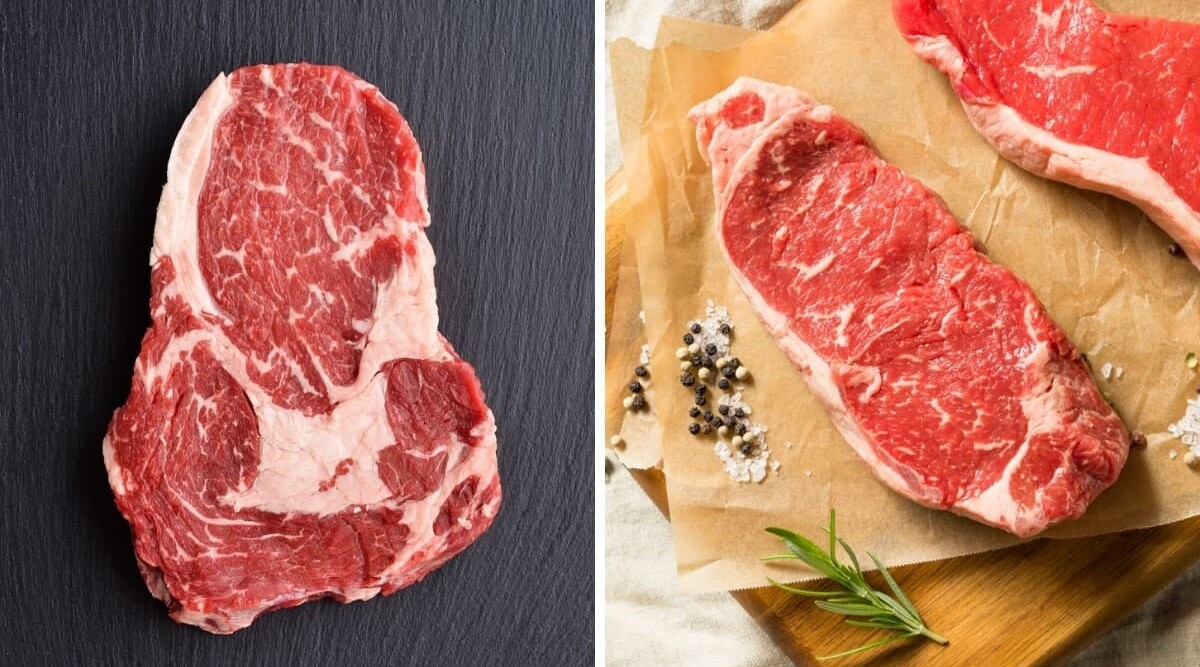
Today, we’re looking at sirloin vs ribeye as part of a series of related articles, where we’re clearing up some mysteries about the major cuts of steak.
They’re both excellent steaks, but what are their distinguishing features? And how should you prepare and cook them?
Sirloin offers a leaner option with less fat, making it a favorite for those looking for a healthier choice without sacrificing taste. On the other hand, ribeye is prized for its rich marbling and deep flavor, appealing to those who crave a more indulgent experience.
But there’s more to it than just this!
Read on to learn where each cut hails from on the cow, alternative names they are known by, their respective fat contents that influence flavor and juiciness, and their nutritional values. By learning these characteristics, how to prepare and cook them, and which is best for you, not only will you have more fun, but you’ll also eat better food more often. And isn’t that the whole point of barbecue?
Let’s get to it.
Jump to:
Ribeye Vs Sirloin Comparison Table
Here’s a bottom line up front, quick comparison table of sirloin and ribeye’s main characteristics side by side.
| Factor | Sirloin | Ribeye |
|---|---|---|
| Average Size and Weight | 6-12 oz, suitable for single servings. | 8-16 oz, larger with generous marbling. |
| Average Servings Per Cut | 1-2 servings, perfect for personal meals. | 1-2 servings, larger cuts can serve more. |
| Fat Content | Lower, with visible fat mainly along the edge. | Higher, with rich marbling throughout. |
| Tenderness | Moderately tender, slightly chewier. | Very tender, thanks to fat marbling. |
| Flavor | Beefy but less rich compared to ribeye. | Rich and beefy, enhanced by fat content. |
| Texture | Firmer texture, less marbled. | Soft and juicy, melts in the mouth. |
| Location on Cow | From the rear back portion, near the hip. | From the rib section, near the upper back. |
| Preferred Cooking Method | Best grilled or broiled, medium-rare to medium. | Ideal grilled or seared, medium-rare for best flavor. |
| Ease of Cooking | Easy, but avoid overcooking to prevent toughness. | Easy, watch for flare-ups due to fat. |
| Nutritional Information | Leaner, around 150 calories, 26g protein, and 1.9g saturated fat fat per 3 oz. | More calories and fat, about 190 calories, 23g protein, and 4g saturated fat per 3 oz. |
| Price | More budget-friendly, less expensive. | Pricier, considered a premium cut. |
After that summary, let’s expand on a few of the details.
Sirloin Vs Ribeye Detailed Comparison
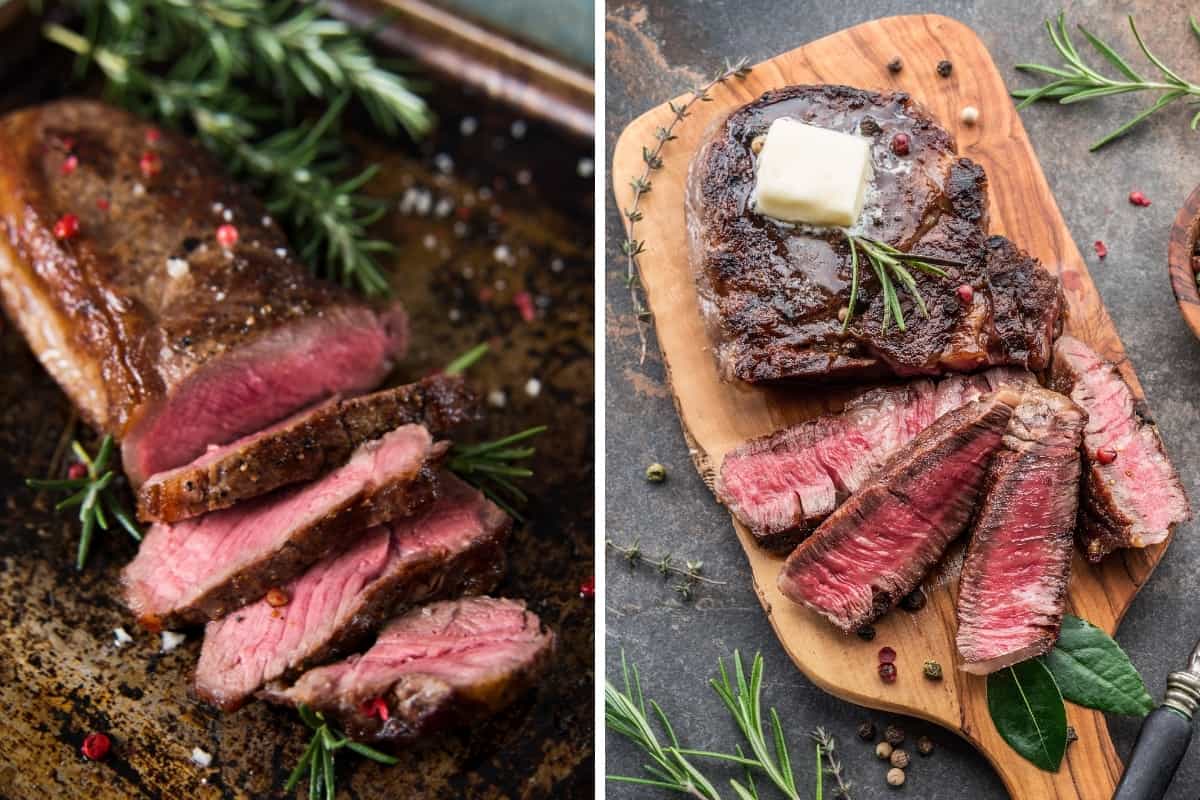
Now that you’ve met the competitors, it’s time for them to face off! Which steak will emerge victorious?
Cooking Methods — is One Easier to Cook Than the Other?
In terms of prep and cooking methods, we have to call this one a draw. You probably won’t need to trim either kind, and there’s no need to marinade sirloin or ribeye steaks. Sirloin steaks will usually cook more quickly than ribeyes, though, being smaller and thinner on average.
The one advantage sirloins have over ribeyes is the lack of fat. Yes, fat equals flavor and juiciness. But, juiciness means drippings and drippings on the barbecue can mean flare-ups. Keep a close eye on your ribeyes to avoid scorching them. If you’re easily distracted or new to grilling, you might pick sirloins for this reason alone.
Is One Better for Grilling Than the Other?
Both of these steaks are excellent for grilling. They are similarly sized and shaped, and both come away tasting amazing. There seems to be a slight preference for sirloin among grilling fans, largely due to the more appealing price and the lower fat content making it easier to cook.
Sirloins also generally come in more manageable sizes than ribeyes, making them an excellent choice for casual and family barbecues.
Difference in Tenderness
Although both are tender cuts, ribeyes definitely score higher in this category than sirloins. All that fat marbling renders on the grill, leaving ribeyes very tender and easy to chew.
Which is More Flavorful?
When it comes to which is more flavorful, though sirloins are no slouches in this area, it’s ribeyes for the win. If big beef flavor is your jam, crank up the ribeye steaks. They pack a ton of flavor into every bite without needing rubs, marinades, or sauces.
Which is USUALLY Bigger?
Of course, we can’t state definitively one is larger than the other. On average, though, ribeye steaks are bigger than sirloins, especially if you get them from a grocer. For larger (or smaller) cuts than average, talk to a butcher and see what you can get.
Which is Better — Sirloin or Ribeye?
It would be tough to think of a more subjective question than this. Each cut enjoys certain advantages over the other. But how to choose which is best between two good cuts of beef?
Feel free to disagree, but we’re going to crown sirloin steaks as our winners in the head-to-head competition. Why? We think sirloin offers a great barbecue experience from fridge to fork for grillers of any skill level.
Consider: sirloin steaks are easy to cook, are both tender and tasty, versatile (cube them, slice them thin, make fajitas, put them on salad, etc.), well-sized, and economically priced for what you get. You can mess around with flavors, and if you make something you don’t like, or happen to overcook your dinner, you won’t feel like you’ve wasted a lot of time or money.
Ribeyes are, obviously, awesome steaks. We highly recommend trying them on the BBQ, especially if you’re confident in your grill skills.
But, sirloins are, to us, the backyard champs from this pairing and should be on every grillers go-to list for satisfying the steak craving.
When Would I Pick One Over the Other?
If I had to choose, I’d say ribeye is my favorite. It’s just so dirty and decadent! Lol. But choosing between sirloin and ribeye isn’t really about picking a favorite for me, it’s about matching the steak to the occasion.
Sirloin is my go-to for a leaner option that still packs a lot of flavors. It’s great for a quick, healthy weeknight dinner when I want something satisfying without too much fat. They’re also excellent served as kabobs, or sliced for fajitas. If I’m planning a Middle Eastern or Mexican menu, go for the sirloin steaks.
On the other hand, ribeye is my choice when I’m looking to indulge. It’s a ribeye that I pull out when it’s all about that beef. Its rich marbling provides a juicier, more flavorful steak that’s perfect for special occasions or when I’m craving something richer and more satisfying.
Both cuts have their merits, and I appreciate them both for what they offer: sirloin for a healthier option and ribeye for indulgence.
Now we’ve compared them side by side, let’s look at each of these cuts in more detail individually.
Sirloin 101
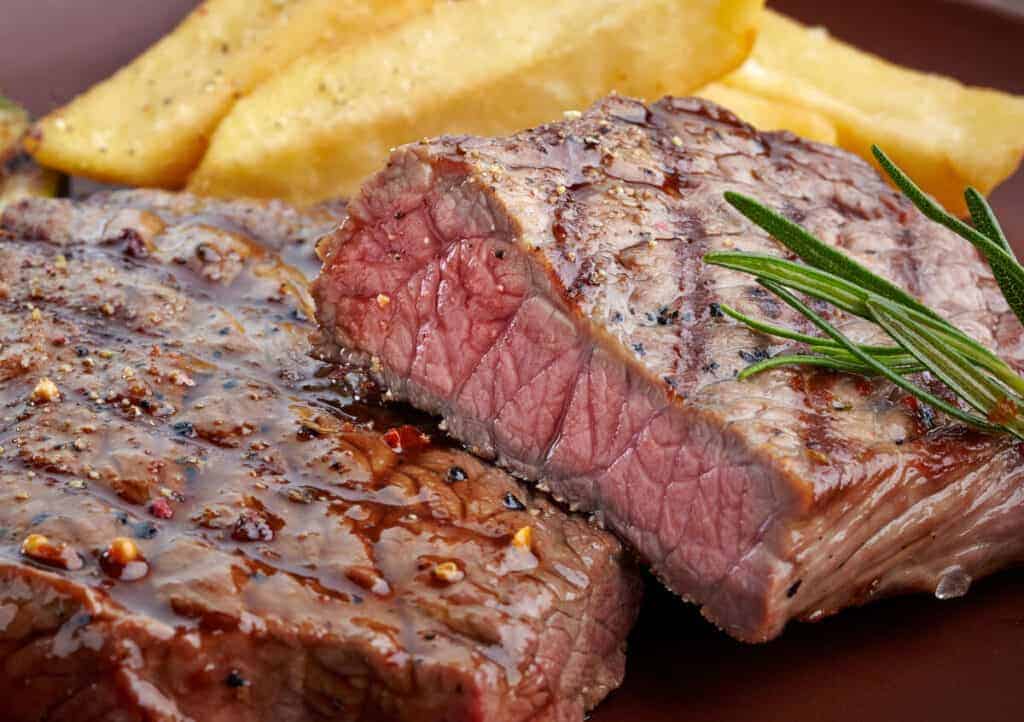
“People generally either love or hate sirloin. It doesn’t carry as much marbling as a ribeye, nor is it tender like a filet, but generally is a good value at the grocery or a steakhouse.” — Melissa Cookston
There is an oft-repeated story that King James I of England ate a steak in Scotland that was so delicious, he knighted the loin. From then on, the tender cut was known as “Sir loin.” It’s a fine tale, but almost certainly untrue.
In fact, the name comes from the Old French word surloigne, meaning “above the loin.” No less historical (the word predates the reign of James I), but far less interesting.
Sirloin steaks are incredibly popular, and you’ll find them in every steakhouse around the world. Actually, most sit-down restaurants in North America offer a sirloin of some description. It’s perhaps the most recognized cut of steak by name, along with filet mignon.
Confusingly, there is more than one kind of sirloin steak. Most commonly, you’ll see simply “sirloin steak” and “top sirloin.” In fact, as discussed in our article what is NY strip steak, the NY strip is a particular cut of boneless top sirloin. The top sirloin comes from a section of the loin close to the tenderloin and is correspondingly more tender than the standard or “bottom” sirloin. All sirloin steaks, however, are decently tender.
While not a cheap steak, sirloin offers great bang for your beef buck.
Where on the Cow Does Sirloin Come from?
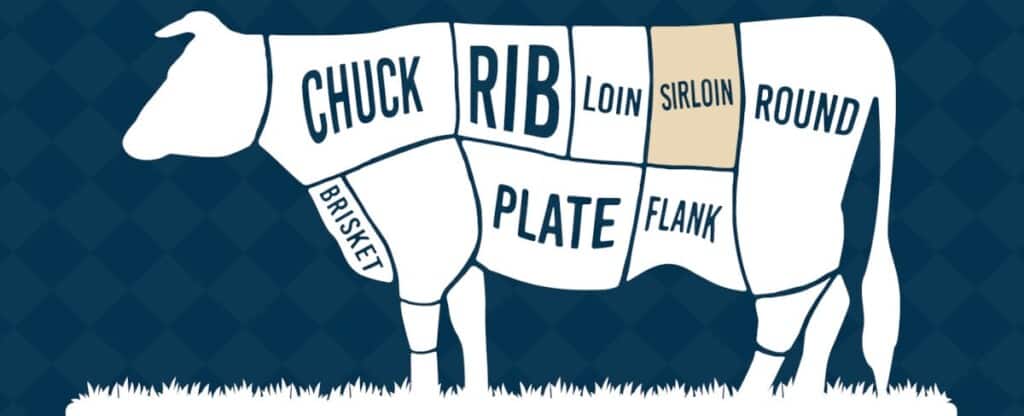
The sirloin primal is located near the rear of the cow, just in front of the round, which is the hindmost primal. Sirloin steaks are cut from either the top sirloin or bottom sirloin subprimals.
Picture a steak in your mind, without a bone. Got it? That’s probably exactly what a sirloin looks like — it’s a classic, elongated oval (or rounded rectangle) cut of muscle, usually 1 to 1.5 inches thick. Porterhouse and T-bone steaks also come from this neighborhood.
How Much Meat and Fat Does Sirloin Contain?
A trimmed sirloin is almost all meat. Fat marbling is generally very light to virtually non-existent, making sirloin one of the leanest cuts of beef available.
This will depend greatly on the cut, however; a center cut sirloin steak may contain one-third as much fat as a top sirloin steak.
Nutritional Information (Top Sirloin)
| Nutrition | Total Amount (Based on 3 oz Serving) | % Daily Value (based on 2000 calories/day) |
|---|---|---|
| Calories | 150 | 8% |
| Saturated Fat | 1.9 g | 10% |
| Protein | 26 g | 52% |
| Iron | 1.6 mg | 10% |
| Zinc | 4.8 mg | 30% |
Portion Size: How Much Sirloin Per Person?
Because sirloin doesn’t taste as naturally rich (because it’s lower in fat) as ribeye, an 8 oz serving should be a manageable portion for most adults. If you really love your beef, 10–12 ounce cuts are widely available.
How to Prepare Sirloin for Grilling or Smoking
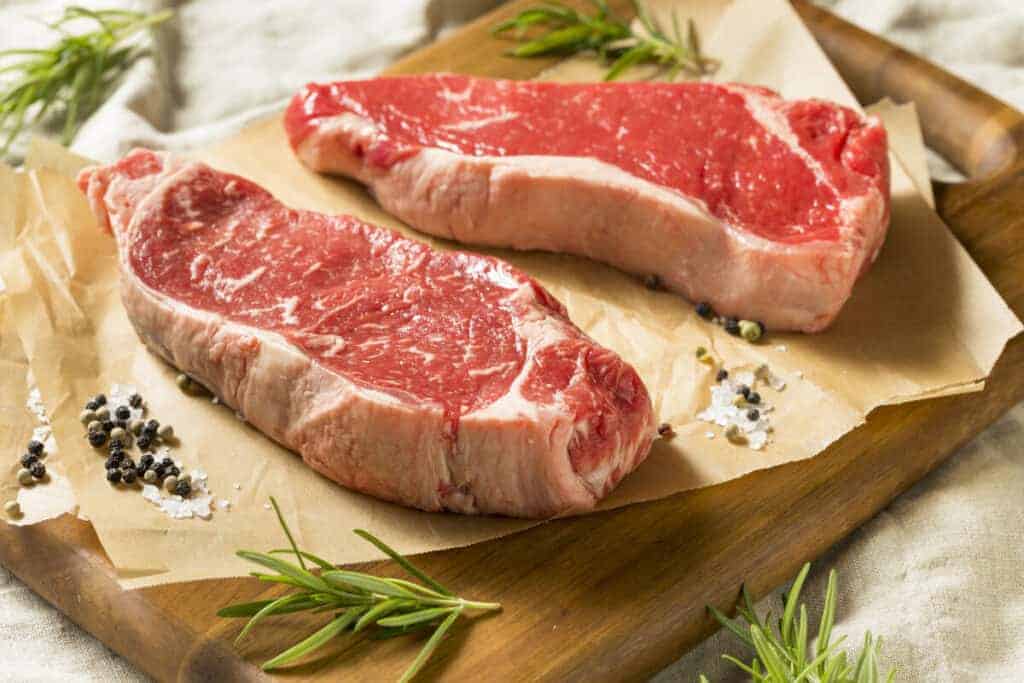
Who else wants to hear that sirloin sizzle? Not so fast — first, we need to prepare that bad boy for the barbecue.
Since a sirloin is very light on fat, there should be no trimming required, particularly if your butcher did his or her job right. It’s a tender steak, but marinating a sirloin, especially a bottom cut, is not out of the question. Don’t leave it too long, though; overnight is overkill — an hour or two is plenty.
In fact, you might just want to give it a salt and pepper rub (kosher salt is best), and perhaps a bit of garlic. Having said that, it’s fun to play with flavors, especially since this is a budget-friendly cut — you’ll be less nervous about “ruining” a sirloin than, say, a filet mignon. Let the sirloin rest on the counter to lose that refrigerator chill for 30 minutes to an hour, depending on thickness.
How to Cook Sirloin
Grill time! And that’s exactly where your sirloin belongs — on a hot grill, over the flame. Set your burners to medium-high on one side and low on the other. For you charcoal grillers, move all the coals to one side to create a 2-zone set-up.
After about 3 minutes over direct heat, flip the sirloin to complete the sear on the opposite side. Another 3 minutes, and you can move over to the indirect heat zone. For thinner cuts cooked to medium-rare, the searing time is probably enough, but check with your digital meat thermometer to be sure.
If you need more time, or like a steak that’s medium or well done, leave it on the indirect side until it’s ready. Find more detail in our guide on how long to grill steak.
Allow about 5 minutes of resting time for the carryover cooking to do its job and for the juices to lock in before serving.
As an alternative, if you have a thin sirloin (under 1 inch thick), consider the afterburner method or using the infrared burner on your grill, if you have one. Either way, the idea is to sear the steak for just a minute or two over incredibly high heat and then rest it. It’s the fastest way to medium rare and will save your thin steaks from drying out.
Ribeye 101
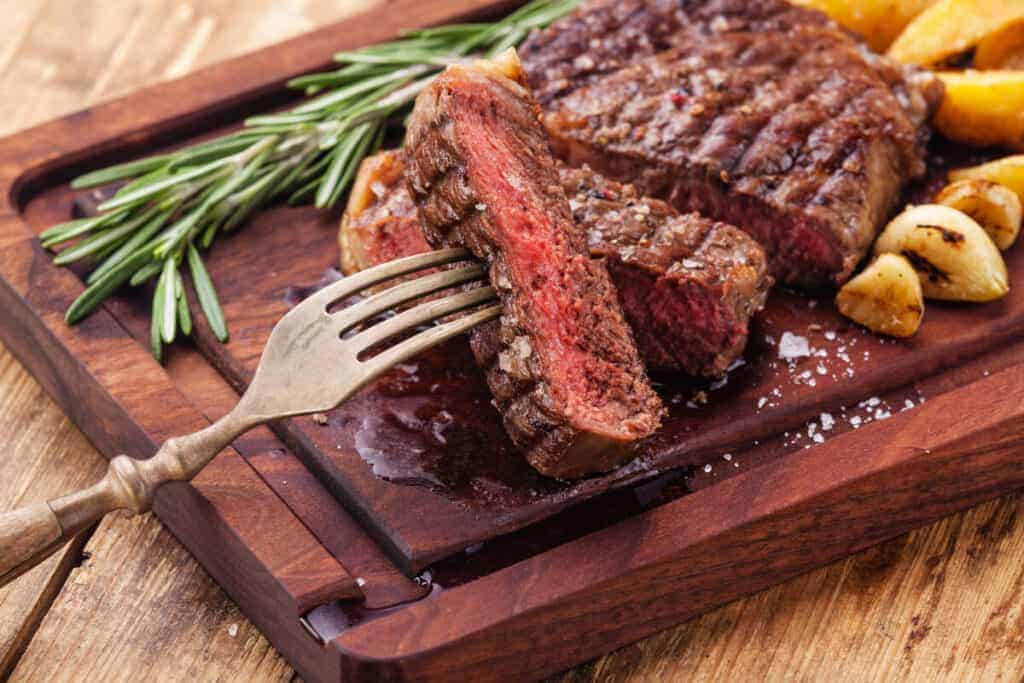
“If the rib eye came from a sheep, it would be a lamb chop. (A very big lamb chop.) Which is to say a tender, juicy, super-well marbled steak.” — Steven Raichlen
So what is a ribeye steak? Taking its name from where it’s cut, the upper rib cage close to the spine, the ribeye (or rib eye, or rib-eye) is a meaty and flavorful steak. As with most steaks, it has several aliases, including market steak, Spencer steak, and beauty steak. Really hoity-toity places might serve it as Scotch fillet or Entrecôte. But, they’re all one and the same steak.
It’s one of the most popular beef steak cuts around the globe thanks to the combination of tenderness and full-bodied flavor. That, and it can be had in oversize 12- and 14-ounce portions, which always looks great on a menu.
If you enjoy tender steak, a ribeye is a great choice. This portion of the cow doesn’t get much exercise, so ribeyes don’t toughen up the way brisket and skirt steak does.
Where on the Cow Does Ribeye Come from?
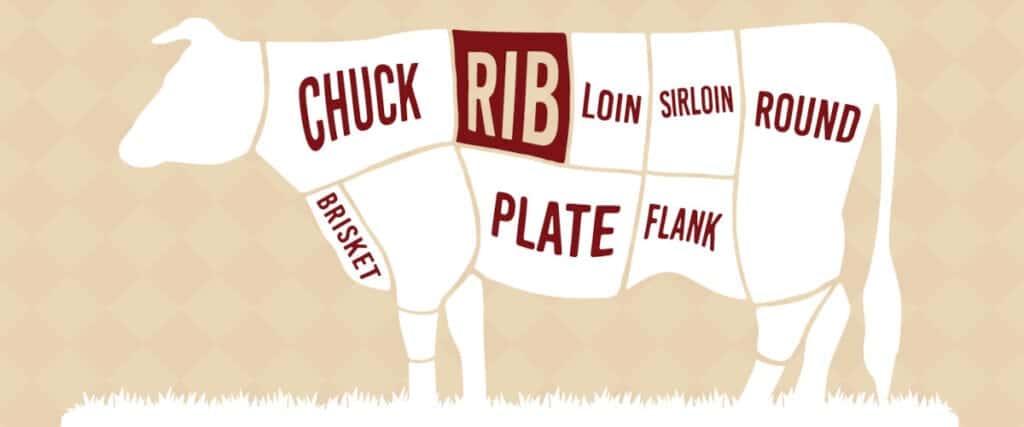
Ribeye doesn’t have rib in the name for nothing; ribeye steaks are cut from the upper section between ribs 6 to 12 on the cow.
Prime rib and rib steak also come from this section — and a rib steak is just a ribeye with the bone still attached. Have you seen or heard of “tomahawk steak”? It’s just a trendy name for a rib steak with an extra long section of rib still attached.
A good ribeye is at least 1.5 inches thick, looks like a wonky oval, and has considerable fat marbling crisscrossing the muscle.
How Much Meat and Fat Does Ribeye Contain?
Being a large cut, there’s a lot of meat on a ribeye. You’ll also find there’s a lot of fat, too. That’s good, though, since fat translates into both flavor and juiciness. On average, a ribeye features more fat than any other steak.
Nutritional Information
| Nutrition | Total Amount (Based on 3 oz Serving) | % Daily Value (based on 2000 calories/day) |
|---|---|---|
| Calories | 190 | 10% |
| Saturated Fat | 4g | 20% |
| Sodium | 60 mg | 3% |
| Protein | 23 g | 46% |
| Iron | 2.2 mg | 10% |
| Zinc | 5 mg | 35% |
Portion Size: How Much Ribeye Per Person?
When we go out for steak, we tend to go for the big numbers in terms of weight (which often means big numbers in the price column!).
Practically speaking, though, a 6-ounce serving is plenty as part of a larger meal. If you’re planning on showcasing the steak with minimal sides (fries are always a great choice!), bump it up to 8–10 ounces.
How to Prepare Ribeye for Grilling or Smoking
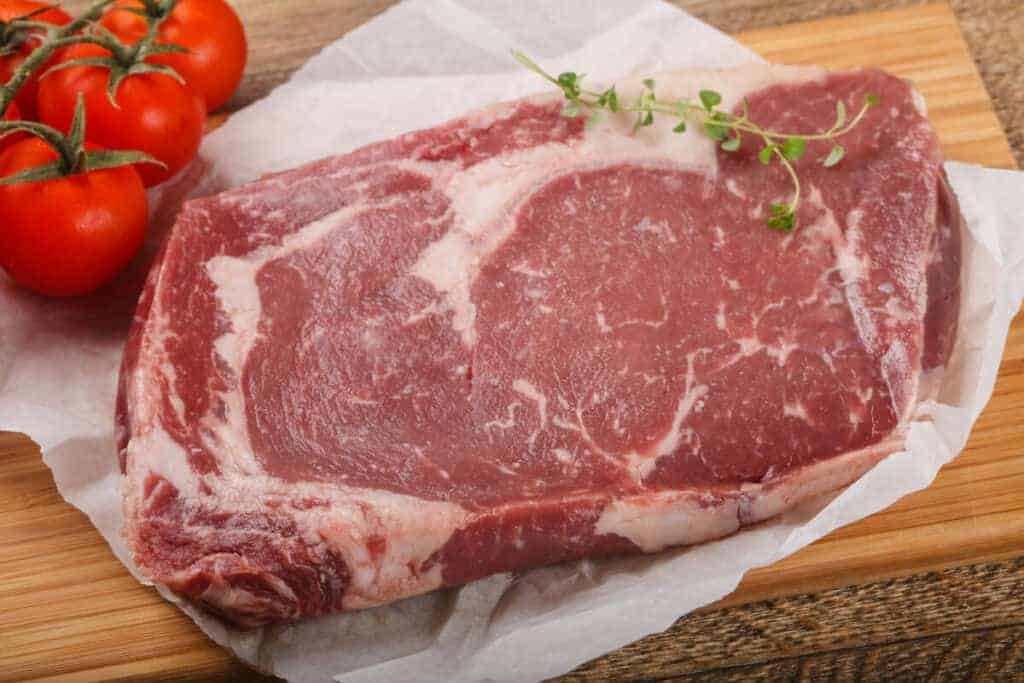
Before you head for the backyard, you may need to do a bit of prep work on your ribeye, first. Here’s what you need to know.
Choose well-marbled ribeyes around 1.5 inches thick. There should be no need to trim anything off, but if you spy some weird bits of fat hanging around, slice them off.
When you’re ready to grill, pull the ribeyes from the fridge and let them rest in the kitchen for anywhere from 30 to 60 minutes. This allows the steaks to safely come up to room temperature; a cold steak won’t cook evenly.
We don’t suggest marinating your ribeye — it’s already tender and flavorful the way it is! Too long in an acid bath (that’s basically what a marinade is) will turn your ribeye to nasty mush. Instead, give it a generous rubbing of kosher salt and pepper to make the flavor pop. You could even mix in some paprika, garlic, or other spices if you’re feeling “extra.”
How to Cook Ribeye
Got your grill warmed up yet? No? Ok, well, now’s the time, while the ribeyes are resting.
Establish two heat zones on your grill, one direct and medium-high, and one indirect and low. That may mean turning on just one burner or moving your charcoal all to one side.
Start by searing the steaks on the direct heat side. Timing will vary by thickness but expect to cook each side for 4 to 5 minutes. Once seared, move the ribeyes to the low-heat zone to finish.
The surest way to gauge doneness is with a digital thermometer. Medium rare is 130F, so you’ll want to take the steaks off the grill at 125F and let them rest for about 5 minutes. Carryover cooking will bring them the rest of the way. For medium to well-done ribeyes (we’re trying not to judge), leave them in the low-heat area for a few minutes, checking with your thermometer to know when they’re ready.
As an option, you can cook ribeyes in a smoker. Choose your favorite wood (preferably something medium- to heavy-flavored) and get it up to 225F. Cook until you’ve reached the right temperature for the doneness you want. Consider adding a quick sear on a hot burner after it’s cooked — this is called a “reverse sear.”
Finally, you can cook your steaks from frozen! There are a few more steps involved, but it’s quicker and easier than waiting for the steak to defrost, and avoids force defrosting which can lessen the quality of the finished product. Find out more in our article on how to grill frozen steak. Though if you really want to defrost your steak, follow our guide on how to defrost steak correctly.
Final Thoughts
Now that you know a bit more about these two great steaks, have you decided which will be next on your grill? Either way, we know you’re going to enjoy a delicious meal. Best of all, you now know you’ve got options when it comes to cooking style and flavor profile. As Homer Simpson once said about donuts — is there anything they can’t do?
If you still have unanswered questions, or if you’ve got tips you’d like to share, fill out the contact form or drop a line — you will get a response! And, as always, you’re encouraged to share this article with your barbecue mates around the globe.
Thanks for reading. And remember — life is too short to eat lousy food!


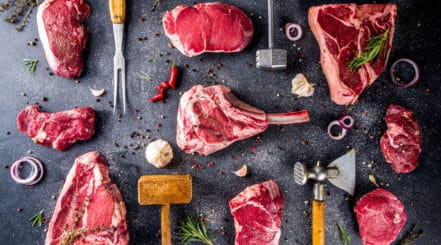


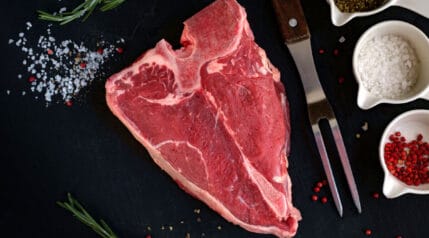
Jim–Not sure I agree. Ribeye steaks do everything a sirloin does-but better. Now, one might not want to serve a huge steak, or may get a great deal on a dozen sirloins, or not want to spend as much for a ribeye, but these are not really qualities of the steak. Ribeye steaks have more flavor, and they are tenderer. How can sirloins be considered better?